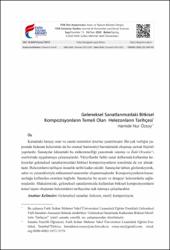Geleneksel Sanatlarımızdaki Bitkisel Kompozisyonların Temeli Olan Helezonların Tarihçesi
Citation
ÖZSOY, Hamide Nur. "Geleneksel Sanatlarımızdaki Bitkisel Kompozisyonların Temeli Olan Helezonların Tarihçesi." FSM İlmî Araştırmalar İnsan ve Toplum Bilimleri Dergisi, 15 (2020): 459-476.Abstract
Kainattaki herşey oran ve orantı sistemleri üzerine yaratılmıştır. Bir çok varlığın yapısında
bulunan helezonlar da bu oransal harmoniyi barındırarak oluşmuş sarmal biçimli
yapılardır. Sanatçılar kâinattaki bu mükemmelliği yansıtmak istemiş ve İlahî Oranlar’ı
eserlerinde uygulamaya çalışmışlardır. Yüzyıllardır farklı sanat dallarında kullanılan helezonlar
geleneksel sanatlarımızdaki bitkisel kompozisyonların temelinde de yer almaktadır.
Helezonların tarihçesi insanlık tarihi kadar eskidir. Sanatçılar tabiatı gözlemleyerek,
sabır ve yetenekleriyle mükemmel tasarımlar oluşturmuşlardır. Kompozisyonların kusursuzluğu
kullanılan oranlara bağlıdır. Sanatçılar bu uyum ve dengeyi helezonlarla sağlamışlardır.
Makalemizde, geleneksel sanatlarımızda kullanılan bitkisel kompozisyonların
temel taşını oluşturan helezonların tarihçesine ışık tutmaya çalışılacaktır. Everything in the universe was created on proportion and proportion systems. Spirals
which exist in the essenace of many entities are formed in spiral-shaped structures that
contain such a proportinal harmony. The artists wanted to reflect this perfection in the
universe and tried to apply the Divine Proportions in their works. Spirals, which have
been used in different art branches for many centuries, also lies at the basis of floral
compositions in our traditional arts. The history of spirals is as old as human history.
The artists observed the nature and formed perfect designs with their patience and talent.
The perfection of the compositions depends on the proportions used. The artists achieved
this harmony and balance with spirals in their works. In our article, we will try to shed
some light on the history of the spirals, which is supposed to be the cornerstone of floral
compositions used in our traditional arts.



















